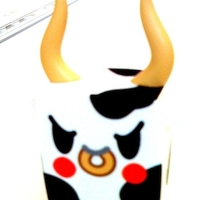Papers by Edwin Veldhuizen
igitur-archive.library.uu.nl
... RNA extraction and cDNA synthesis Total cellular RNA from lung tissue from healthy female Ros... more ... RNA extraction and cDNA synthesis Total cellular RNA from lung tissue from healthy female Ross 308 broiler chicken was extracted using TRIzol© (Invitrogen, Carlsbad, CA) and Magnalyser Green Beads (Roche Diagnostics GmbH, Mannheim, Germany Diagnostics GmbH ...
Journal of Back and Musculoskeletal Rehabilitation, 2020

Pathogens
Salmonellosis is a common infection in poultry, which results in huge economic losses in the poul... more Salmonellosis is a common infection in poultry, which results in huge economic losses in the poultry industry. At the same time, Salmonella infections are a threat to public health, since contaminated poultry products can lead to zoonotic infections. Antibiotics as feed additives have proven to be an effective prophylactic option to control Salmonella infections, but due to resistance issues in humans and animals, the use of antimicrobials in food animals has been banned in Europe. Hence, there is an urgent need to look for alternative strategies that can protect poultry against Salmonella infections. One such alternative could be to strengthen the innate immune system in young chickens in order to prevent early life infections. This can be achieved by administration of immune modulating molecules that target innate immune cells, for example via feed, or by in-ovo applications. We aimed to review the innate immune system in the chicken intestine; the main site of Salmonella entrance...
mSphere
Antibiotic resistance is a pressing problem and estimated to be a leading cause of mortality by 2... more Antibiotic resistance is a pressing problem and estimated to be a leading cause of mortality by 2050. Antimicrobial peptides, also known as host defense peptides (HDPs), and HDP-derived antimicrobials have potent antimicrobial activity and high potential as alternatives to antibiotics due to low resistance development.

Journal of Advanced Research
Introduction: Due to the increase of antibiotic resistant bacterial strains, there is an urgent n... more Introduction: Due to the increase of antibiotic resistant bacterial strains, there is an urgent need for development of alternatives to antibiotics. Cathelicidins can be such an alternative to antibiotics having both a direct antimicrobial capacity as well as an immunomodulatory function. Previously, the full Denantiomer of chicken cathelicidin-2 (D-CATH-2) has shown to prophylactically protect chickens against infection 7 days post hatch when administered in ovo three days before hatch. Objectives: To further evaluate D-CATH-2 in mammals as a candidate for an alternative to antibiotics. In this study, the prophylactic capacity of D-CATH-2 and two truncated derivatives, D-C(1-21) and D-C (4-21), was determined in mammalian cells. Methods: Antibacterial assays; immune cell differentiation and modulation; cytotoxicity, isothermal titration calorimetry; in vivo prophylactic capacity of peptides in an S. suis infection model. Results: D-CATH-2 and its derivatives were shown to have a strong direct antibacterial capacity against four different S. suis serotype 2 strains (P1/7, S735, D282, and OV625) in bacterial medium and even stronger in cell culture medium. In addition, D-CATH-2 and its derivatives ameliorated the efficiency of mouse bone marrow-derived macrophages (BMDM) and skewed mouse bone marrow-derived dendritic cells (BMDC) towards cells with a more macrophage-like phenotype. The peptides directly bind lipoteichoic acid (LTA) and inhibit LTA-induced activation of macrophages. In addition, S. suis killed by the peptide was unable to further activate mouse macrophages, which indicates that S. suis was eliminated by the previously reported silent killing mechanism. Administration of D-C(1-21) at 24 h or 7 days before infection resulted in a small prophylactic protection with reduced disease severity and reduced mortality of the treated mice. Conclusion: D-enantiomers of CATH-2 show promise as anti-infectives against pathogenic S. suis for application in mammals.

Applied Microbiology and Biotechnology
Therapeutic options to treat invasive fungal infections are still limited. This makes the develop... more Therapeutic options to treat invasive fungal infections are still limited. This makes the development of novel antifungal agents highly desirable. Naturally occurring antifungal peptides represent valid candidates, since they are not harmful for human cells and are endowed with a wide range of activities and their mechanism of action is different from that of conventional antifungal drugs. Here, we characterized for the first time the antifungal properties of novel peptides identified in human apolipoprotein B. ApoB-derived peptides, here named r(P)ApoBLPro, r(P)ApoBLAla and r(P)ApoBSPro, were found to have significant fungicidal activity towards Candida albicans (C. albicans) cells. Peptides were also found to be able to slow down metabolic activity of Aspergillus niger (A. niger) spores. In addition, experiments were carried out to clarify the mechanism of fungicidal activity of ApoB-derived peptides. Peptides immediately interacted with C. albicans cell surfaces, as indicated by ...

Therapeutic solutions to counter Burkholderia cepacia complex (Bcc) bacteria are challenging due ... more Therapeutic solutions to counter Burkholderia cepacia complex (Bcc) bacteria are challenging due to their intrinsically high level of antibiotic resistance. Bcc organisms display a variety of potential virulence factors, have a distinct lipopolysaccharide naturally implicated in antimicrobial resistance and are able to form biofilms, which may further protect them from both host defence peptides (HDPs) and antibiotics. Here, we report the extremely promising anti-biofilm and immunomodulatory activities of human HDP GVF27 on two of the most clinically relevant Bcc members, as Burkholderia multivorans and Burkholderia cenocepacia. The effects of synthetic and labelled GVF27 were tested on B. cenocepacia and B. multivorans biofilms, at three different stages of formation, by alternative microscopy approaches. Assays on bacterial cultures and on human monocytes challenged with B. cenocepacia LPS, were also performed. GVF27 exerts, at different stages of formation, meaningful anti-biofil...

Animals
In recent years, diseases caused by pathogenic bacteria have profoundly impacted chicken producti... more In recent years, diseases caused by pathogenic bacteria have profoundly impacted chicken production by causing economic loss in chicken products and by-product revenues. MBL (mannose-binding lectin) is part of the innate immune system (IIS), which is the host’s first line defense against pathogens. The IIS functions centrally by identifying pathogen-specific microorganism-associated molecular patterns (MAMPs) with the help of pattern recognition receptors (PRRs). Studies have classified mannose-binding lectin (MBL) as one of the PRR molecules which belong to the C-type lectin family. The protective role of MBL lies in its ability to activate the complement system via the lectin pathway and there seems to be a direct link between the chicken’s health status and the MBL concentration in the serum. Several methods have been used to detect the presence, the level and the structure of MBL in chickens such as Enzyme-linked immunosorbent assay (ELISA), Polymerase Chain Reaction (PCR) among...

Frontiers in Microbiology
Gram-negative bacteria release vesicular structures from their outer membrane, so called outer me... more Gram-negative bacteria release vesicular structures from their outer membrane, so called outer membrane vesicles (OMVs). OMVs have a variety of functions such as waste disposal, communication, and antigen or toxin delivery. These vesicles are the promising structures for vaccine development since OMVs carry many surface antigens that are identical to the bacterial surface. However, isolation is often difficult and results in low yields. Several methods to enhance OMV yield exist, but these do affect the resulting OMVs. In this review, our current knowledge about OMVs will be presented. Different methods to induce OMVs will be reviewed and their advantages and disadvantages will be discussed. The effects of the induction and isolation methods used in several immunological studies on OMVs will be compared. Finally, the challenges for OMV-based vaccine development will be examined and one example of a successful OMV-based vaccine will be presented.
Current Research in Microbial Sciences

Veterinary Research
Cathelicidins (CATHs) play an important role in the innate immune response against microbial infe... more Cathelicidins (CATHs) play an important role in the innate immune response against microbial infections. Among the four chicken cathelicidins, CATH-B1 is studied the least. In this study, the effect of CATH-B1 on the macrophage response towards avian pathogenic E. coli (APEC) and bacterial ligands was investigated. Our results show that APEC induced CATH-B1 gene expression in both a chicken macrophage cell line (HD11 cells) and primary macrophages, while expression of the other three CATHs was virtually unaffected. While the antimicrobial activity of CATH-B1 is very low under cell culture conditions, it enhanced bacterial phagocytosis by macrophages. Interestingly, CATH-B1 downregulated APEC-induced gene expression of pro-inflammatory cytokines (IFN-β, IL-1β, IL-6 and IL-8) in primary macrophages. In addition, CATH-B1 pre-incubated macrophages showed a significantly higher gene expression of IL-10 after APEC challenge, indicating an overall anti-inflammatory profile for CATH-B1. Usi...

Frontiers in Microbiology
Cathelicidins (CATHs) are host defense peptides (HDPs) that play an important role in the innate ... more Cathelicidins (CATHs) are host defense peptides (HDPs) that play an important role in the innate immune response against infections. Although multiple functions of cathelicidins have been described, including direct antimicrobial activity and several immunomodulatory effects on the host, relatively little is known about their antiviral activity. Therefore, in vitro antiviral activity of chicken cathelicidins and the underlying mechanism was investigated in this study against different influenza A virus (IAV) strains. Our results show that chicken CATH-B1 has broad anti-IAV activity compared to other cathelicidins (CATH-1,-2,-3, LL-37, PMAP-23, and K9CATH) with an inhibition of viral infection up to 80% against three tested IAV strains (H1N1, H3N1, and H5N1). In agreement herewith, CATH-B1 affected virus-induced inflammatory cytokines expression (IFN-β, IL-1β, IL-6, and IL-8). Incubation of cells with CATH-B1 prior to or after their inoculation with virus did not reduce viral infection indicating that direct interaction of virus with the peptide was required for CATH-B1's antiviral activity. Experiments using combined size exclusion and affinity-based separation of virus and peptide also indicated that CATH-B1 bound to viral particles. In addition, using electron microscopy, no morphological change of the virus itself was seen upon incubation with CATH-B1 but large aggregates of CATH-B1 and viral particles were observed, indicating that aggregation might be the mechanism of action reducing IAV infectivity. Neuraminidase (NA) activity assays using monovalent or multivalent substrates, indicated that CATH-B1 did not affect NA activity per se, but negatively affected the ability of virus particles to interact with multivalent receptors, presumably by interfering with hemagglutinin activity. In conclusion, our results show CATH-B1 has good antiviral activity against IAV by binding to the viral particle and thereby blocking viral entry.

Developmental & Comparative Immunology
Avian pathogenic Escherichia coli (APEC) can cause severe respiratory diseases in poultry. The in... more Avian pathogenic Escherichia coli (APEC) can cause severe respiratory diseases in poultry. The initial interaction between APEC and chicken macrophages has not been characterized well and it is unclear how effective chicken macrophages are in neutralizing APEC. Therefore, the effect of APEC on activation of chicken macrophage HD11 cells was studied. Firstly, the effect of temperature (37 vs 41°C) on phagocytosis of APEC by HD11 cells was determined. The results showed that APEC was more susceptible to being phagocytosed by HD11 cells at 41°C than 37°C. Subsequently, the capacity of HD11 cells to kill APEC was shown. In addition, HD11 cells produced nitric oxide (NO) at 18 h post-infection and a strong increase in the mRNA expression of IL-8, IL-6, IL-1β and IL-10 was detected, while IFN-β gene expression remained unaffected. Finally, it was shown that the response of HD11 was partially dependent on viability of APEC since stimulation of HD11 cells with heat-killed APEC resulted in a reduced expression level of these cytokines. In conclusion, APEC induces an effector response in chicken macrophages by enhanced NO production and cytokines gene expression.

Veterinary Immunology and Immunopathology
Virulent strains of Escherichia coli (Avian Pathogenic E. Coli: APEC) can cause initial infection... more Virulent strains of Escherichia coli (Avian Pathogenic E. Coli: APEC) can cause initial infection of the respiratory tract in chickens potentially leading to systemic infection called colibacillosis, which remains a major cause of economic losses in the poultry industry. The role of epithelial lung cells as first targets of APEC and in initiating the innate immune response is unclear and was investigated in this study. APEC was able to adhere and subsequently invade cells from the chicken lung epithelial CLEC213 cell line exhibiting pneumocyte type II-like characteristics. Invasion was confirmed using confocal microscopy after infection with GFP-labelled APEC. Moreover, the infection resulted in a significant increase in IL-8 gene expression, a chemo-attractant of macrophages and heterophils. Gene expression of interferon α and β were not significantly upregulated and chicken Surfactant Protein A, also did not show a significant upregulation on either gene or protein level. The immune response of CLEC213 cells towards APEC was shown to be similar to stimulation with E. coli LPS. These results establish CLEC213 cells as a novel model system for studying bacterial infection of the lung epithelium and show that these cells may play a role in the initial innate response towards bacterial pathogens.

Molecular Immunology
At the lung lining innate defenses protect our lungs against inhaled fungal cells that could pose... more At the lung lining innate defenses protect our lungs against inhaled fungal cells that could pose a threat to our health. These defenses are comprised of mucociliary clearance, soluble effector molecules and roaming phagocytic cells, such as macrophages and neutrophils. How important each of these defenses is during fungal clearance depends on the specific fungal pathogen in question and on the stage of infection. In this study the localization and antifungal activity of the lung surfactant protein D (SP-D) was studied in an environment mimicking the lung lining. To this end Calu-3 cells were grown on an air-liquid interface allowing them to polarize and to produce mucus at their apical surface. Additionally, neutrophils were added to study their role in fungal clearance. Two fungal pathogens were used for these experiments: Candida albicans and Aspergillus fumigatus, both of clinical relevance. During fungal infection SP-D localized strongly to both fungal surfaces and stayed bound through the different stages of infection. Furthermore, SP-D decreased fungal adhesion to the epithelium and increased fungal clearance by neutrophils from the epithelial surface. These findings suggest that SP-D plays an important role at the different stages of pulmonary defense against fungal intruders.

Veterinary Immunology and Immunopathology
Keratinocytes (KC) are the main cellular components of the stratum corneum that constitutes a sol... more Keratinocytes (KC) are the main cellular components of the stratum corneum that constitutes a solid physical skin barrier representing the first line of defense against pathogens. Moreover, KC are potent producers of inflammatory mediators and antimicrobial peptides (AMP) when activated through their pattern recognition receptors. In atopic dermatitis (AD) the protective skin barrier may be compromised due to barrier disruption, secondary infection and accelerated secretion of inflammatory cytokines which may also affect AMP expression in the skin. In the present study, we addressed the responses of a canine KC cell line upon exposure to Staphylococcus pseudintermedius, typically found on canine atopic skin during secondary infections, and stimulation by individual AD-associated ligands and cytokines. All stimuli induced a significant increase in expression of the pro-inflammatory cytokine genes tumor necrosis factor (TNF)-α and interleukin (IL)-8, but with different kinetics. Limited effects were observed on AMP gene expression except for K9CATH which was significantly upregulated upon bacterial infection but with none of the individual AD-associated ligands. Interestingly, K9CATH possessed antimicrobial activity towards Staphylococcus pseudintermedius, indicating that K9CATH expression is a specific defense reaction towards bacterial infection and not part of a general pro-inflammatory profile of KC.

Veterinary immunology and immunopathology, 2018
Macrophages play an important role in the innate immune system as part of the mononuclear phagocy... more Macrophages play an important role in the innate immune system as part of the mononuclear phagocyte system (MPS). They have a pro-inflammatory signature (M1-polarized macrophages) or anti-inflammatory signature (M2-polarized macrophages) based on expression of surface receptors and secretion of cytokines. However, very little is known about the culture of macrophages from pigs and more specific about the M1 and M2 polarization in vitro. Porcine monocytes or mononuclear bone marrow cells were used to culture M1- and M2-polarized macrophages in the presence of GM-CSF and M-CSF, respectively. Surface receptor expression was measured with flow cytometry and ELISA was used to quantify cytokine secretion in response to LPS and PAMCSK stimulation. Human monocyte-derived macrophages were used as control. Porcine M1- and M2-polarized macrophages were cultured best using porcine GM-CSF and murine M-CSF, respectively. Cultures from bone marrow cells resulted in a higher yield M1- and M2-polari...

Scientific reports, Jan 19, 2017
Cathelicidins are short cationic peptides initially described as antimicrobial peptides, which ca... more Cathelicidins are short cationic peptides initially described as antimicrobial peptides, which can also modulate the immune system. Because most findings have been described in the context of human LL-37 or murine CRAMP, or have been investigated under varying conditions, it is unclear which functions are cathelicidin specific and which functions are general cathelicidin properties. This study compares 12 cathelicidins from 6 species under standardized conditions to better understand the conservation of cathelicidin functions. Most tested cathelicidins had strong antimicrobial activity against E. coli and/or MRSA. Interestingly, while more physiological culture conditions limit the antimicrobial activity of almost all cathelicidins against E. coli, activity against MRSA is enhanced. Seven out of 12 cathelicidins were able to neutralize LPS and another 7 cathelicidins were able to neutralize LTA; however, there was no correlation found with LPS neutralization. In contrast, only 4 cat...

Scientific reports, Jan 14, 2017
Cystic fibrosis (CF) is characterized by recurrent airway infections with antibiotic-resistant ba... more Cystic fibrosis (CF) is characterized by recurrent airway infections with antibiotic-resistant bacteria and chronic inflammation. Chicken cathelicin-2 (CATH-2) has been shown to exhibit antimicrobial activity against antibiotic-resistant bacteria and to reduce inflammation. In addition, exogenous pulmonary surfactant has been suggested to enhance pulmonary drug delivery. It was hypothesized that CATH-2 when combined with an exogenous surfactant delivery vehicle, bovine lipid extract surfactant (BLES), would exhibit antimicrobial activity against CF-derived bacteria and downregulate inflammation. Twelve strains of CF-pathogens were exposed to BLES+CATH-2 in vitro and killing curves were obtained to determine bactericidal activity. Secondly, heat-killed bacteria were administered in vivo to elicit a pro-inflammatory response with either a co-administration or delayed administration of BLES+CATH-2 to assess the antimicrobial-independent, anti-inflammatory properties of BLES+CATH-2. CAT...

Frontiers in microbiology, 2017
Fungal infections of the lung are life-threatening but rarely occur in healthy, immunocompetent i... more Fungal infections of the lung are life-threatening but rarely occur in healthy, immunocompetent individuals, indicating efficient clearance by pulmonary defense mechanisms. Upon inhalation, fungi will first encounter the airway surface liquid which contains several soluble effector molecules that form the first barrier of defense against fungal infections. These include host defense peptides, like LL-37 and defensins that can neutralize fungi by direct killing of the pathogen, and collectins, such as surfactant protein A and D, that can aggregate fungi and stimulate phagocytosis. In addition, these molecules have immunomodulatory activities which can aid in fungal clearance from the lung. However, existing observations are based on in vitro studies which do not reflect the complexity of the lung and its airway surface liquid. Ionic strength, pH, and the presence of mucus can have strong detrimental effects on antifungal activity, while the potential synergistic interplay between sol...








Uploads
Papers by Edwin Veldhuizen